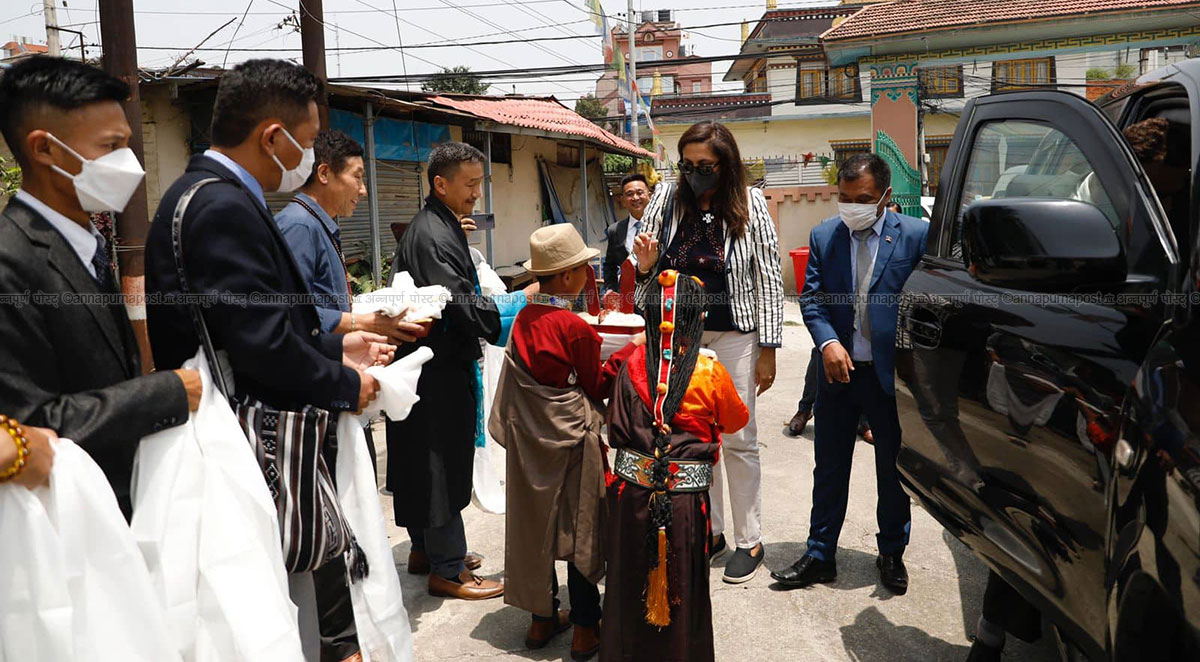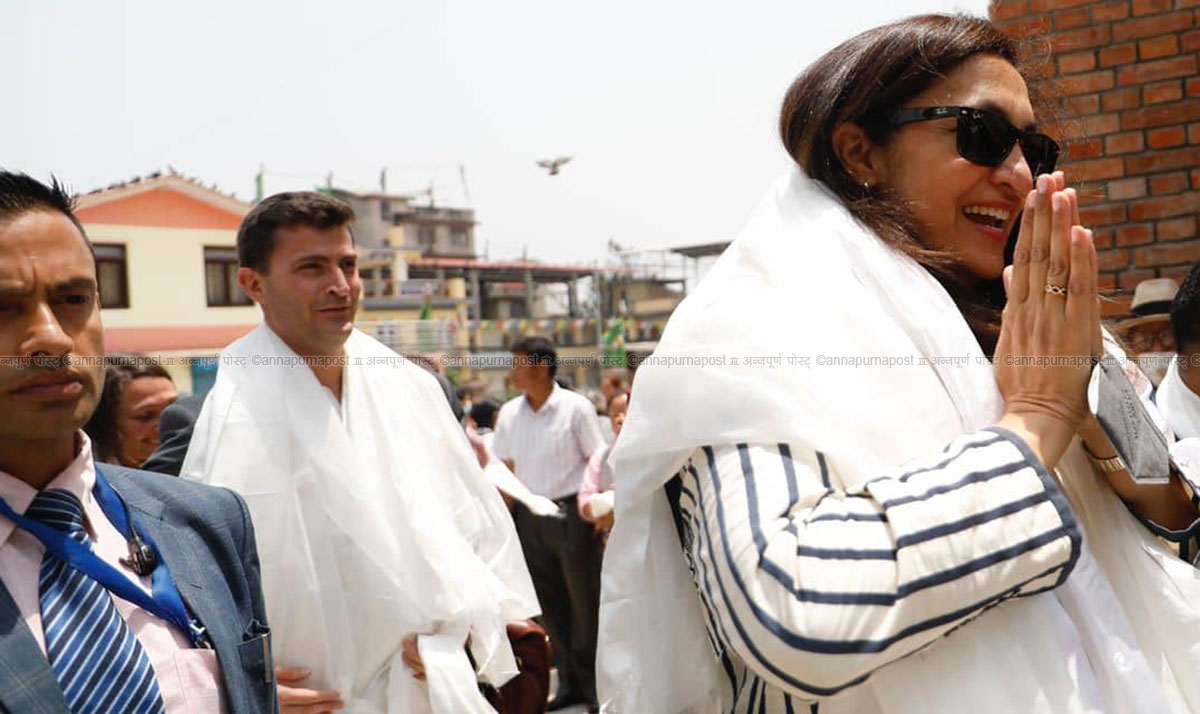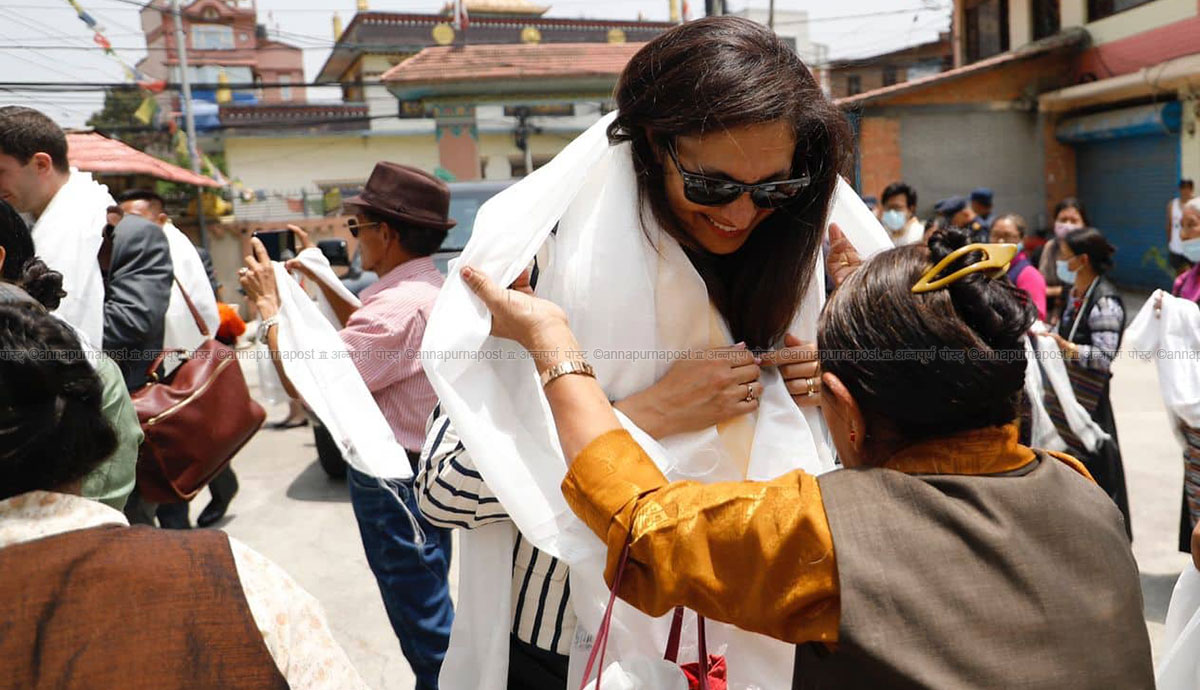US Under Secretary of State Zeya pays courtesy call on PM Deuba
Under Secretary for Civilian Security, Democracy and Human Rights and US Special Coordinator for Tibetan Issues Uzra Zeya paid a courtesy call on Prime Minister Sher Bahadur at the latter's residence in Baluwatar on Sunday.
"It was a pleasure receiving the US delegation led by Under Secretary of State for Civilian Security, Democracy and Human Rights @UnderSecStateJ. We exchanged views on Nepal-US relations and matters of mutual interests," Deuba tweeted on Sunday.
Zeya along with the deputy chief is US embassy visit Tibetan camp in Jawalakhel, Lalitpur on Saturday.
During the visit, she had inquired about the physical and other facilities like health and education in the camp.
She also held interaction with the Tibetan refugees living in the camp.
Earlier on Friday, Foreign Ministry spokesperson during a regular press conference said that the government was not aware of any meetings between Zeya and Tibetan refugee leaders in Kathmandu.
Independent mayoral candidate Balen Shah leading by 16, 934 votes in KMC
Independent mayoral candidate of Kathmandu Metropolitan City Balen Shah has stretched his lead by 16, 934 votes.
He garnered 39, 006 votes while his closest contender Srijana Singh of Nepali Congress secured 22, 072 votes.
Singh has left CPN-UML candidate Keshav Sthapit behind. Sthapit received 21, 571 votes.
Similarly, deputy mayoral candidate Sunita Dangol of CPN-UML is leading the vote count.
Rameshwar Shrestha of CPN (Unified Socialist) is lagging far behind.
Demonstration held in Kathmandu demanding action against Mahato’s killers
A group of activists and youths staged a demonstration at Maitighar of Kathmandu on Saturday demanding action against those involved in the murder of environmental activist Dilip Kumar Mahato of Mithila, Dhanusha.
They staged the demonstration demanding justice to Mahato and action against the murderers.
Likewise, they have also demanded that Mahato be declared an environmental martyr.
Similarly, the activists have also urged the government to shut down all the crusher industries being operated illegally across the country.
Mahato was crushed to death by a tipper for protesting illegal extraction of riverbed materials in Dhanusha on January 10, 2020.
Concert at Namche on Everest Day
Namche Youth Club and Party Everest International are jointly organizing a musical event and DJ night at Namche Bazar, Solukhumbu on 29 May 2022 starting from 5 in the evening with a theme ‘Party at the top of the world’.
Every year on Everest Day, this group organizes a concert in Solukhumbu.
The event will feature artists like Sugam Pokharel, Milan Newar, Trishna Gurung, Subani Moktan, DJ Tenzing, Bishwo Dong, Jenny Sherpa, Chhiring Wangchu Sherpa along with local artists to entertain numbers of local and international tourists.
Saigrace announces ‘Word Tour 2022’
Saigrace Pokharel, the ace storyteller, famous among the Nepali diaspora across the globe has announced his world tour—‘Word Tour 2022’.
His show is happening in the USA, UK, Australia, France, Belgium , Denmark, and Germany.

Shows:
July 3: London, UK
August 6: Sydney, Australia
August 14 Melbourne, Australia
October 16: New York, USA
For more: Saigrace Pokharel
US Special Coordinator for Tibetan Issues Uzra Zeya visits Tibetan camp in Jawalakhel
Under Secretary for Civilian Security, Democracy and Human Rights and US Special Coordinator for Tibetan Issues Uzra Zeya, who is on a Nepal visit, inspected the Tibetan refugee camp in Jawalakhel on Saturday.
A team of Zeya along with the deputy chief of the US embassy reached the Jawalakhel this afternoon.
During the visit, she had inquired about the physical and other facilities like health and education in the camp.
She also held interaction with the Tibetan refugees living in the camp.

On the occasion, some Tibetan community leaders told Zeya that some Tibetan refugees have been deprived of even basic human rights due to lack of ID cards.
Earlier on Wednesday, Chinese Ambassador to Nepal Hou Yanqi, during the meeting with Home Minister Bal Krishna Khand, had expressed her concern over the visit of US Special Coordinator for Tibetan Issues Zeya to Nepal.
The government has not given 'refugee identity cards' to the Tibetan refugees since 1995.
Refugee leaders in Nepal have said that the Tibetan refugees have been deprived of employment due to lack of refugee identity cards.

According to a source at the Home Ministry, Zeya is expected to urge Prime Minister Sher Bahadur Deuba and other high-ranking Nepali officials to issue refugee ID cards to the Tibetans who have not got the ID card at the earliest.

In a strong message to China, U.S Special Coordinator on Tibet meets Tibetan community representatives
U.S. Special Coordinator on Tibet Uzra Zeya, who is currently on a three-day visit to Nepal, met with the representatives of the Tibetan community in Kathmandu, on May 21.
The visit is being seen as a strong message to China. In recent weeks, U.S and China are at fresh loggerheads over Taiwan and Tibet issues.

On May 21, she visited the Tibetan refugee camp at Lalitpur followed by a visit to Boudhanath Stupa. In Lalitpur, she held discussions with representatives of the Tibetan community about their human rights issues. Before arriving in Nepal, she visited Dharmashala, India, and met spiritual leader Dalai Lama.
China has opposed US Under Secretary and Special Coordinator for Tibetan Issues Uzra Zeya’s meeting with the head of the “Tibetan government-in-exile” and some Tibetan representatives in India on May 18 in Dharmashala, India.
Chinese Foreign Ministry Spokesperson Zhao Lijian in a regular press briefing on May 19 said the so-called “Tibetan government-in-exile” is an out-and-out separatist political group and an illegal organization in total violation of China’s Constitution and laws. It is not recognized by any country in the world, he said. The U.S is urging the Nepal government to ensure the human rights of Tibetan refugees in Kathmandu.

America, however, has accused China of misrepresenting its policy on Tibet and Taiwan. Ned Price, State Department Spokesperson on May 21 said, “The United States does not subscribe to the PRC’s “one China principle” – we remain committed to our longstanding, bipartisan one-China policy, guided by the Taiwan Relations Act, Three Joint Communiques, and Six Assurances.”
The United States has said it strongly advocates for Taiwan to regain its observer status in the World Health Assembly (WHA) the decision-making body of the World Health Organization (WHO), leading into its annual meeting May 22-28 in Geneva.

One held for raping beauty pageant participant eight years ago
Police on Saturday arrested a man on the charge of raping one of the participants of a beauty pegeant eight years ago.
A team deployed from the Kathmandu Valley Crime Investigation Office apprehended beauty pegeant organizer Manoj Pandey from Swoyambu of Kathmandu this afternoon.
DIG Uttam Raj Subedi of the Metropolitan Police Office, Ranipokhari said that Pandey was taken under control for interrogation.
Earlier on Wednesday, the girl came out with a series of videos on TikTok claiming that she was drugged and raped in 2014 when she was16-year-old.
People have been staging demonstrations for the past few days in various places of Kathmandu to express solidarity and to demand action against the perpetrators.
Meanwhile, the government on Friday formed a five-member probe committee to investigate the incident of a girl who was sexually abused eight years while taking part in a beauty pageant.
The committee was formed under the leadership of senior SP Basant Kunwar.
SP Krishna Koirala, DSP Kopila Chudal, DSP Hari Basnet and Inspector Sapana Khadka are the members of the committee.














